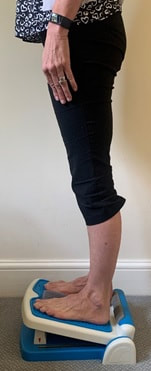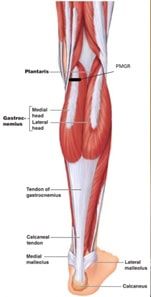- Chichester Foot and Ankle
- Foot and ankle conditions
- Treatments
- Foot and ankle referrals
-
Resources
- Sites of foot pain
- Links to other foot and ankle services and resources
- Internal
-
Rehab protocols
>
- Rehabilitation from achiles tendon rupture treated without surgery using VACOped boot
- Recovery from achilles rupture without surgery using VACOped boot
- Rehabilitation from achilles tendon rupture treated without surgery using Boot and Wedges
- Rehabilitation from achilles tendon rupture treated with surgery in Aircast boot and wedges
- Foot and Ankle rehabilitation
|
Proximal Medial Gastroc Release (PMGR) Surgery
This is a commonly performed procedure designed to lengthen part of your calf muscle. Tightness in this muscle has been associated with numerous foot and ankle conditions such as plantar fasciitis, forefoot pain (such as that caused by mortons neuroma, freiburgs disease and metatarsalgia), and achilles disorders such as mid-substance achilles tendinopathy (often called achilles tendinitis) or insertional achilles tendinitis. How does it work? You will normally have a regime of calf stretching or slant board exercises to accompany your surgery. The procedure works by lengthening one half of the y-shaped gastrocnemius muscle which runs from your femur bone (above the knee) all the way to your heel, via your achilles tendon. The procedure works by changing the point of maximum tension in this muscle whilst you walk. By reducing this tension, the surgery takes the pressure off the painful part of your body, allowing it to heal. How is the surgery done? The procedure itself is carried out as a daycase operation. Most patients will have the procedure under local anaesthetic, meaning they are completely awake and can rapidly go home after surgery. The operation is performed via a transverse incision of three to four centimetres just behind the knee joint. The procedure usually takes around 20 minutes. Local anaesthetic is administered during surgery to numb the area. If you need surgery on both sides this can be done at the same sitting although this is usually performed under spinal or general anaesthetic. What are the risks? The risks of PMGR surgery include the potential for infection or wound breakdown, the risk of injury to the communicating branch of the sural nerve which can cause pain, numbness or tingling, the potential for blood clots, calf cramps (which usually improve with quinine sulphate tablets if they occur), the potential for ongoing pain or even worsening things if you were to suffer a complication. What is the recovery like? You will need to rest over the few days after surgery and elevate your foot. During this time you will need blood thinning medication. By one week after surgery most patients are walking fairly comfortably and can mobilise without restriction. You will need to keep the wound clean and dry for two weeks. You should re-start slant board exercises or calf stretches as soon as possible. As the calf settles you can resume all activity as is comfortable at the rate that is appropriate for you. Most patients will be settling for several months after the surgery. |
|
Oving Clinic
Tel: 01243773167 |
Chichester Nuffield
Private secretary: Sarah Brown Tel: 01243753022 |
Goring Hall secretary:
Nicole Murray Tel: 01903953201 |
Copyright © 2015
- Chichester Foot and Ankle
- Foot and ankle conditions
- Treatments
- Foot and ankle referrals
-
Resources
- Sites of foot pain
- Links to other foot and ankle services and resources
- Internal
-
Rehab protocols
>
- Rehabilitation from achiles tendon rupture treated without surgery using VACOped boot
- Recovery from achilles rupture without surgery using VACOped boot
- Rehabilitation from achilles tendon rupture treated without surgery using Boot and Wedges
- Rehabilitation from achilles tendon rupture treated with surgery in Aircast boot and wedges
- Foot and Ankle rehabilitation



